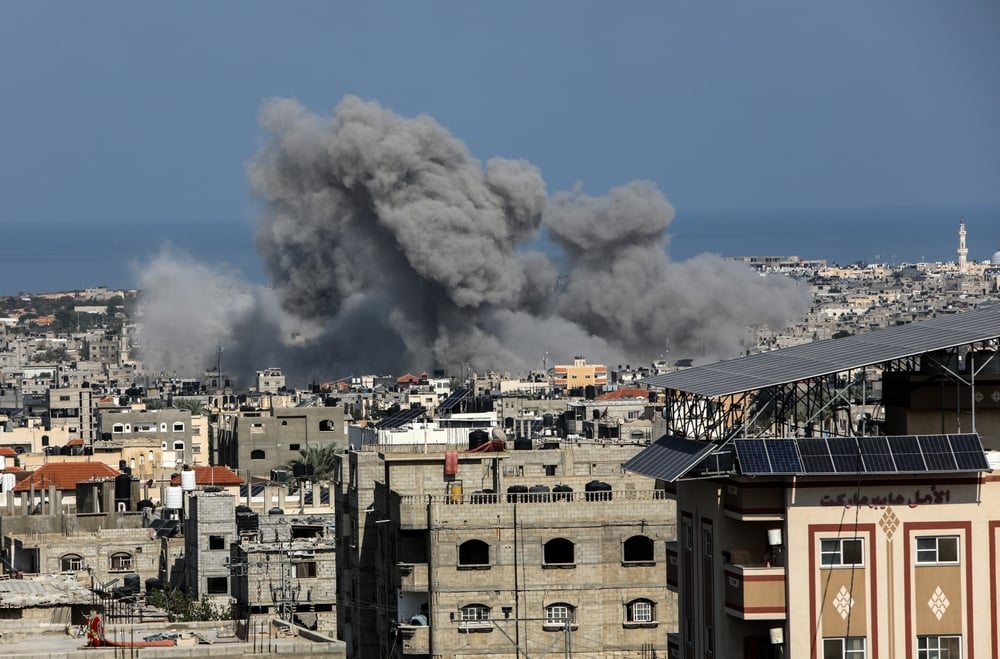In a significant escalation, Israeli forces moved tanks into the western section of Gaza’s Nuseirat refugee camp on Monday, sparking widespread fear and chaos among residents. This latest incursion into central Gaza saw tanks opening fire as they advanced, with witnesses describing the scene as one of sheer panic. Zaik Mohammad, a 25-year-old resident living approximately one kilometer from the targeted area, shared his perspective on the sudden strike. “Some people couldn’t leave and remained trapped inside their homes, appealing to be allowed out, while others rushed out with whatever they could carry as they fled,” he told Reuters via a chat app.
Civilian Casualties and Medical Reports
Palestinian medical officials reported that at least 30 people were killed since Sunday night due to Israeli military strikes. Health authorities at Al-Awda Hospital in Nuseirat stated that 20 of those deaths resulted from a series of air and ground strikes, one of which hit a tent encampment, underscoring the conflict’s severe toll on civilians. In northern Gaza’s Beit Lahiya, which has seen sustained Israeli military activity since early October, an airstrike claimed the lives of four people, according to medics.
The violence extended to medical facilities, with three medical workers wounded by Israeli drone fire at Kamal Adwan Hospital near Beit Lahiya. This marked a troubling development for healthcare providers already grappling with a dire situation in the war-torn enclave.
Context of the Israeli Offensive
The ongoing conflict in Gaza has now entered its 14th month, with Israel intensifying operations in the north and central regions as part of what it describes as an effort to disrupt Hamas militants and prevent them from regrouping. This focus has led to large-scale evacuations, prompting tens of thousands of Palestinians to flee their homes amid growing concern that they may never be allowed to return. The situation remains tense as the potential for a ceasefire remains elusive; efforts led by Qatar were paused over the weekend, with mediators citing a lack of willingness from both sides to reach an agreement.
Targeted Strikes and Commanders
The Israeli military announced it had killed Mohammad Abu Skhail, a senior commander within the Islamic Jihad group, during a strike on Saturday at a command center inside a repurposed school compound in Gaza City. The attack reportedly resulted in six casualties, according to Palestinian medical sources. Despite Monday’s escalating violence, there was no official comment from Israel regarding the day’s events.
Growing Humanitarian Concerns
The combination of military incursions, targeted airstrikes, and the rising number of civilian casualties has amplified calls for humanitarian relief and increased fears of a prolonged conflict. The strikes on refugee camps and medical facilities are drawing attention to the urgent need for aid and protection for those caught in the crossfire.
The advance into Gaza’s Nuseirat camp marks a pivotal moment in the ongoing conflict, reflecting Israel’s broader strategy to exert pressure on militant groups while raising grave concerns over the impact on civilians. As the situation continues to evolve, the humanitarian toll and the potential for further escalation remain pressing issues for both local and international observers.
Keywords: Gaza conflict, Nuseirat camp, Israeli incursion, Palestinian casualties, airstrikes, humanitarian crisis, evacuation, Islamic Jihad, medical facilities, ceasefire efforts.
Weeks-Long Siege on Gaza Hospitals
In a deeply troubling turn of events, Israeli forces have laid siege to three hospitals in and around Jabalia for several weeks. Despite orders to evacuate, hospital officials have refused to abandon their facilities or patients, even as critical supplies of food, fuel, and medical resources dwindle. The Israeli military maintains that Hamas is using Gaza’s civilian infrastructure, including hospitals, for military operations, an accusation that the militant group denies.
Military Operations and Expanding Humanitarian Measures
The Israeli army has been active in the northern Gaza areas of Beit Lahiya, Beit Hanoun, and Jabalia for over a month, deploying tanks and conducting raids aimed at dismantling militant capabilities. Israeli military sources report that hundreds of Hamas and Islamic Jihad fighters have been killed in these operations. In response, the armed wings of Hamas and Islamic Jihad have claimed successful ambushes, mortar attacks, and anti-tank rocket assaults, stating they have inflicted casualties on Israeli soldiers.
Amid the military pressure, Israel announced on Monday that it would expand a “humanitarian zone” within Gaza. The military also pledged to allow the entry of more tents, shelter materials, and vital supplies such as food, water, and medicine, aiming to address the urgent needs of the civilian population.
A Humanitarian Crisis with No Safe Haven
The situation in Gaza has reached a critical point, with Palestinian and United Nations officials emphasizing that no place in the densely populated enclave, home to over 2.1 million residents, is safe. The sustained military campaign has left much of Gaza in ruins. Health officials in Gaza report that around 43,500 Palestinians have been killed since the conflict began, a devastating figure highlighting the immense human toll.
The Origins and Escalation of the Conflict
The conflict, now in its 14th month, erupted on October 7, 2023, when Hamas launched a surprise attack on Israeli communities, resulting in the deaths of approximately 1,200 Israelis and the capture of 253 hostages, according to Israeli figures. In response, Israel has pursued an aggressive military campaign targeting Gaza’s infrastructure, aiming to dismantle Hamas and secure the release of abductees. The campaign has had profound and tragic effects on Gaza’s civilian population, contributing to widespread displacement and destruction.
As the conflict in Gaza persists, the siege of hospitals and ongoing military operations underscore the severe humanitarian crisis faced by residents. The expanded “humanitarian zone” and increased aid efforts are steps toward alleviating some of the suffering, but the overarching conflict continues to place immense strain on the population. With over 2.1 million people impacted and countless lives lost, the call for peace and a sustainable resolution grows ever more urgent.





















